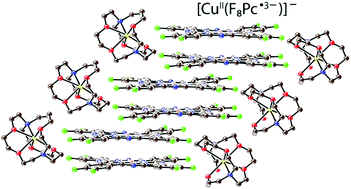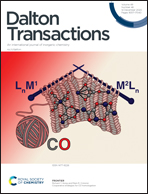Effect of reduction on the molecular structure and optical and magnetic properties of fluorinated copper(ii) phthalocyanines†
Abstract
The reduction of copper(II) octafluoro- {CuII(F8Pc)} and hexadecafluorophthalocyanines {CuII(F16Pc)} by NaCpCo(CO)2 in the presence of cryptand[2.2.2] yields new crystalline {cryptand(Na+)}[CuII(F8Pc)˙3−]−·2C6H4Cl2 (1) and {cryptand(Na+)}2[CuII(F16Pc)4−]2−·C6H14 (2) salts. Together with two previously characterized salts of CuII(FxPc) (x = 8 and 16), this allows the study of the molecular structure and optical and magnetic properties of fluorinated copper phthalocyanines in different reduction states (−1 and −2). The blue shift of the Q-band increases together with the negative charge on the macrocycle, and new weak bands of the anions appear at 820–1013 nm. Alternation of the Nmeso–C bonds manifests itself in reduced macrocycles due to a partial disruption of macrocycle aromaticity. In the case of CuII(F8Pc) this effect is nearly two times stronger for dianions than for monoanions. The alternation of the bonds is less pronounced for perfluorinated CuII(F16Pc)n− (n = 1, 2) anions most probably due to a partial delocalization of the negative charge on fluoro-substituents. The reduction also noticeably elongates the average C–F bonds in CuII(F8Pc). The first reduction centered on the macrocycle leads to the formation of [CuII(F8Pc)˙3−]− in 1 with two S = 1/2 spins positioned on CuII and the radical trianion (F8Pc)˙3− macrocycle. As a result, a broad EPR signal is observed with g = 2.1652 at RT attributable to both paramagnetic species having exchange interactions. The formation of dimerized stacks from [CuII(F8Pc)˙3−]− in 1 results in strong enough magnetic coupling of the (F8Pc)˙3− spins within the dimers (J/kB = −21.8 cm−1), and weaker intramolecular coupling is observed between CuII and (F8Pc)˙3− (J/kB = −10.8 cm−1). Coupling between (F8Pc)˙3− spins from the neighboring dimers is nearly 1.5 times weaker (−14.6 cm−1). Under reduction conditions, a second electron also comes to the macrocycle forming diamagnetic F16Pc4− tetraanions. In this case S = 1/2 spin is preserved on CuII. Magnetic coupling between these centers is weak due to the long distances between them in the [CuII(F8Pc)4−]2− chains of 2. Salt 2 shows an EPR signal with a HF splitting characteristic of CuII with g∥ = 2.1806 (A∥ = 20.11 mT), and g⊥ = 1.9597 at RT.



 Please wait while we load your content...
Please wait while we load your content...
